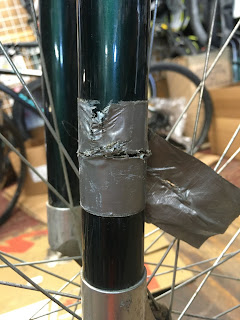When mountain biking boomed and took the bike industry with it, to levels of social popularity really never seen in the industry's entire history, it made biking -- particularly on mountain bikes -- part of the general culture of the country for almost a decade. Mountain biking was accessible, affordable, and widely appealing.
As the activity evolved, its tributaries exerted their influence and ultimately narrowed its focus, turning mountain biking into a subculture.
Culture is inclusive. It draws from social connections outside of itself to weave a discrete activity like riding what was then considered an off-road bike into the general lifestyle of a majority of people. Only a minority of participants actually spent a lot of time on technical trails, but the bikes were affordable and fun to ride, with a popular configuration. They were simple enough to modify readily to suit an individual rider's preferences. The bikes were everywhere, along with a general sense of belonging at least to some degree to a vast and accessible community.
Subculture is exclusive. It develops its own language and customs, designed to exclude the masses in favor of the qualified. Anybody with the money can buy the equipment, but it takes knowledge and experience to become a recognized member of the group.
Fragmentation is inevitable as personal styles gravitate to each other. Tribal affiliations form around specific types of riding. Within these tribes, hierarchies develop. In mountain biking, rank depends on exposure to personal injury. Whether it's overuse injury or crash injury, the group is isolated from the main stream of society by its adherence to technical off-road riding, and further narrowed by its adulation for participants with no sense of personal safety. The biggest risk takers are the most admired. Below them are the riders of lesser skill and daring, who may be completely content at their level. Some of them may pose or aspire to higher status, but many of them just enjoy their personal best and are happy to be part of the scene. It's safer than riding the road, while at the same time perceived as ballsier because of the public spectacle of stunt riders performing sick tricks and even releasing the videos of their spectacular failures. How else will the audience appreciate the extreme risk involved in being a true master of this thing that doesn't need to be done?
Not every category of biking forms a subculture. Mountain biking and BMX are strongly subcultural. Recreational path riding isn't subcultural at all, except to the extent that not everyone in our general culture rides a bike at all. But path riders and urban transportation cyclists don't have the special clothing and conscious pursuit of fitness and technique that other disciplines of riding have. Any category that uses special shoes and pants is a subculture at this point. At the height of mountain biking's cultural saturation, bike shorts and shoes were darn near mainstream, but they aren't now. Whether you wear tight, shiny shorts with a chamois or proudly display your disdain for aerodynamics and crotch padding with your off-road attire, it's generally tailored to riding. And flat shoes for shin-gouging flat pedals are still "biking shoes" just as much as pointy little hard-soled things with a cleat on the bottom.
Mountain biking now depends on constructed courses. The better ones offer trails with varying degrees of difficulty, in order to attract and maintain the interest of riders who will inject money into the subculture's economic sector to help support the interests to the minority of elite performers. This is much more vulnerable to economic fluctuations than the old exploratory style of off-road and dirt road riding that we pursued in the early years. We had to worry somewhat about land closure, but one's vulnerability was directly proportional to one's addiction to a certain kind of terrain.
When I gave up mountain biking near the turn of the century, it was to build a bike that would get me through just about any public right of way depicted on a map, before anyone had decided that "gravel" was a category and tried to exploit it as a profit center for the struggling bike industry in the wake of mountain biking's collapse. I'm still riding the same bike more than 20 years later, on the same type of publicly accessible right of way. Some of them are too deteriorated for regular practical passage, but most are useful connectors, and I don't concern myself with whether they are paved or not. I also don't have to worry about whether they will be too muddy. Most of them are kept clear and passable at least half the year by some government entity at the state or local level.
The Surly Cross Check was eminently practical. Naturally, it generated very little interest. In that way it was similar to the Pugsley -- ancestor of the fat bike movement -- in the way that it languished for many years, developing a slowly growing following before hitting a critical mass and contributing to the birth of a category that the industry could claim suddenly to have invented. I wouldn't ride it slam-bang down rough trails, but it gets me around on a lot of interesting roads less traveled. It used parts that could be mixed, matched, and substituted, for ease of maintenance and better odds of repair if you happened to need it somewhere far from home. It would fit nicely into culture, if culture should embrace simple bikes again.

















